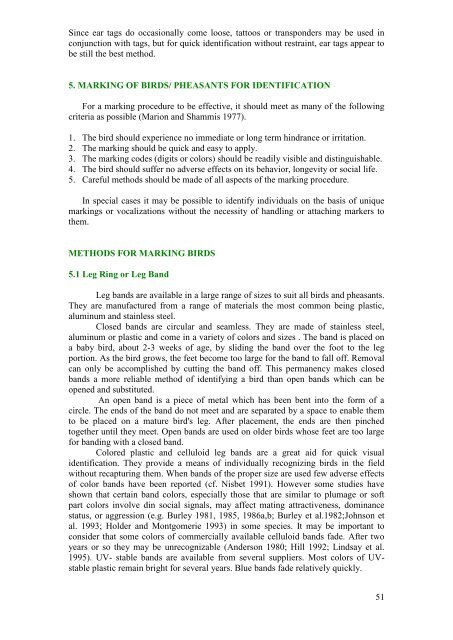standardization of records keeping in indian zoos - Central Zoo ...
standardization of records keeping in indian zoos - Central Zoo ...
standardization of records keeping in indian zoos - Central Zoo ...
Create successful ePaper yourself
Turn your PDF publications into a flip-book with our unique Google optimized e-Paper software.
S<strong>in</strong>ce ear tags do occasionally come loose, tattoos or transponders may be used <strong>in</strong><br />
conjunction with tags, but for quick identification without restra<strong>in</strong>t, ear tags appear to<br />
be still the best method.<br />
5. MARKING OF BIRDS/ PHEASANTS FOR IDENTIFICATION<br />
For a mark<strong>in</strong>g procedure to be effective, it should meet as many <strong>of</strong> the follow<strong>in</strong>g<br />
criteria as possible (Marion and Shammis 1977).<br />
1. The bird should experience no immediate or long term h<strong>in</strong>drance or irritation.<br />
2. The mark<strong>in</strong>g should be quick and easy to apply.<br />
3. The mark<strong>in</strong>g codes (digits or colors) should be readily visible and dist<strong>in</strong>guishable.<br />
4. The bird should suffer no adverse effects on its behavior, longevity or social life.<br />
5. Careful methods should be made <strong>of</strong> all aspects <strong>of</strong> the mark<strong>in</strong>g procedure.<br />
In special cases it may be possible to identify <strong>in</strong>dividuals on the basis <strong>of</strong> unique<br />
mark<strong>in</strong>gs or vocalizations without the necessity <strong>of</strong> handl<strong>in</strong>g or attach<strong>in</strong>g markers to<br />
them.<br />
METHODS FOR MARKING BIRDS<br />
5.1 Leg R<strong>in</strong>g or Leg Band<br />
Leg bands are available <strong>in</strong> a large range <strong>of</strong> sizes to suit all birds and pheasants.<br />
They are manufactured from a range <strong>of</strong> materials the most common be<strong>in</strong>g plastic,<br />
alum<strong>in</strong>um and sta<strong>in</strong>less steel.<br />
Closed bands are circular and seamless. They are made <strong>of</strong> sta<strong>in</strong>less steel,<br />
alum<strong>in</strong>um or plastic and come <strong>in</strong> a variety <strong>of</strong> colors and sizes . The band is placed on<br />
a baby bird, about 2-3 weeks <strong>of</strong> age, by slid<strong>in</strong>g the band over the foot to the leg<br />
portion. As the bird grows, the feet become too large for the band to fall <strong>of</strong>f. Removal<br />
can only be accomplished by cutt<strong>in</strong>g the band <strong>of</strong>f. This permanency makes closed<br />
bands a more reliable method <strong>of</strong> identify<strong>in</strong>g a bird than open bands which can be<br />
opened and substituted.<br />
An open band is a piece <strong>of</strong> metal which has been bent <strong>in</strong>to the form <strong>of</strong> a<br />
circle. The ends <strong>of</strong> the band do not meet and are separated by a space to enable them<br />
to be placed on a mature bird's leg. After placement, the ends are then p<strong>in</strong>ched<br />
together until they meet. Open bands are used on older birds whose feet are too large<br />
for band<strong>in</strong>g with a closed band.<br />
Colored plastic and celluloid leg bands are a great aid for quick visual<br />
identification. They provide a means <strong>of</strong> <strong>in</strong>dividually recogniz<strong>in</strong>g birds <strong>in</strong> the field<br />
without recaptur<strong>in</strong>g them. When bands <strong>of</strong> the proper size are used few adverse effects<br />
<strong>of</strong> color bands have been reported (cf. Nisbet 1991). However some studies have<br />
shown that certa<strong>in</strong> band colors, especially those that are similar to plumage or s<strong>of</strong>t<br />
part colors <strong>in</strong>volve d<strong>in</strong> social signals, may affect mat<strong>in</strong>g attractiveness, dom<strong>in</strong>ance<br />
status, or aggression (e.g. Burley 1981, 1985, 1986a,b; Burley et al.1982;Johnson et<br />
al. 1993; Holder and Montgomerie 1993) <strong>in</strong> some species. It may be important to<br />
consider that some colors <strong>of</strong> commercially available celluloid bands fade. After two<br />
years or so they may be unrecognizable (Anderson 1980; Hill 1992; L<strong>in</strong>dsay et al.<br />
1995). UV- stable bands are available from several suppliers. Most colors <strong>of</strong> UV-<br />
stable plastic rema<strong>in</strong> bright for several years. Blue bands fade relatively quickly.<br />
51
















